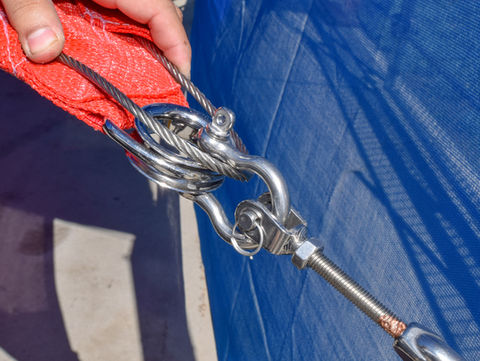
Home / Design & Install / Installing the Sail
Installing the Sail
Installation
Now that you have received your custom shade sail, it's time to install it.
Remember, your attachment points should already be placed. You did that first and then took the measurements to order your sail.
Our sails come with the cable already installed in the pocket. If you have a sail that does not already have the cable in place, you will need to feed the cable through the pockets.

Step 1: Attach the Corner Hardware
Start by attaching all of your corner hardware.
Attach the corner D Rings to the Bow Shackle, making sure to capture both the D Ring and the Cable.
Next, attach your Turnbuckle to the Bow Shackle. Open each Turnbuckle to the maximum length making sure that a few threads from each end are visible inside the Turnbuckle body.
We recommend that you use a Turnbuckle and Bow Shackle at each corner for maximum flexibility during the initial installation.

Step 2: Attach the Corners
If you have any Direct Connection points, you will attach the Bow Shackle directly to the attachment point.
Turnbuckles can be directly connected to your attachment point. If you are having trouble reaching the point or the Turnbuckle doesn't fit around the attachment loop, it can be connected via an extra Bow Shackle.
If you are installing a Keder or A-Rail sail, you should install the Keder side first, followed by the corners at either side of the Keder. Then you will attach the remaining corners just like you would any other sail.
As you get to the third or fourth corners, you will find that the sail will be very tight and difficult to pull toward your attachment point. You will likely need a ratchet strap or rope to help you pull the corner close enough to secure. Use whichever tool fits the space best to get the job done.

Step 3: Tighten the Cable and Cable Clamps
Pull the ends of the Cable hand tight. Check to make sure there that the Cable is seated in the thimble at each corner.
Feed the ends of the cable around the corner hardware and stick them back into the pockets. Place a clamp on either side of the corner hardware. Snug the cable again if needed and tighten the Cable Clamps.
Note: The pictures below were taken with the sail on the ground so that we could properly demonstrate this step. You will do this while the sail is attached.

Step 4: Tighten the Turnbuckles
Make sure to lubricate the threads with an anti-seize compound or white lithium grease.
Tighten Turnbuckles until the sail is smooth and taught. Observe the threads making sure to rotate the Turnbuckle body in the proper direction to tighten it. Turning the Turnbuckle body the wrong way will loosen it causing the Turnbuckle ends to fall out and the sail to fall down. Then tighten the lock nuts on each side of the Turnbuckle.
This should provide the correct amount of tension to the sail. Any small wrinkles will work themselves out over time.

Step 5: Lock and Safety Wire Hardware
Shade sails will move slightly with the wind. You must lock down the Turnbuckles and put a Safety Wire on the hardware to keep it from vibrating loose.
Safety Cable:
Last, but not least, we recommend attaching Safety Cables for larger sails.
Corner hardware fails for a variety of reasons, but it is the most dangerous kind of failure. Imagine a storm with high winds has caused your turnbuckle to come loose and the eye bolt to break. Now you have a heavy set of hardware; turnbuckle, bow shackle, and D ring thimble, flapping about in the wind causing damage and potential injuries. We always recommend that you take down your sails before a heavy storm with high winds, but as we all know, accidents happen.
A good way to help prevent this kind of accident is to connect a safety cable to the D Ring and your attachment point.

































